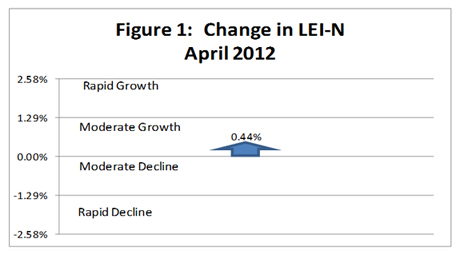The Leading Economic Indicator for Nebraska increased by 0.44 percent in April, reversing a decline during March. Takentogether, changes in the indicator for April and March suggest the Nebraskaeconomy will grow slowly during the fall.
The Leading Economic Indicator for Nebraska, produced by faculty and students in the Department of Economics and Bureau of Business Research in the UNL College of Business Administration, is a composite of six components that predict future economic growth. They are single-family building permits, airline passenger counts, initial unemployment claims, manufacturing hours, the value of the U.S. dollar and business expectations gathered from the
Survey of Nebraska Business.

May Leading Economic Indicator - Nebraska
“A sharp decline in initial unemployment claims made the largest contribution to the increase in the indicator,” said University of Nebraska-Lincoln economist Eric Thompson, director of the Bureau of Business Research. “This decline in layoffs indicates that businesses expect to need their workforce in the coming months to meet envisioned production and sales. This was confirmed in responses to the
Survey of Nebraska Business, with businesses expecting to add employees over the next six months.”
Manufacturing hours also increased during April. Other components of the leading indicator, however, declined. Building permits and airline passenger counts both dropped. The value of the U.S. dollar also increased, which would tend to reduce Nebraska export activity.
Thompson said that growth in the Leading Economic Indicator for Nebraska in April, combined with a decline in the indicator in March, provide a cautious outlook for the Nebraska economy later this year.
“While the outlook for growth this summer is solid, leading indicator data from March and April suggest slow growth in the Nebraska economy during the fall,” he said.
Published: May 18, 2012